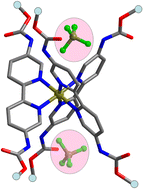Anion binding by metallo-receptors of 5,5′-dicarbamate-2,2′-bipyridine ligands†
Abstract
Three

* Corresponding authors
a
Key Laboratory of Synthetic and Natural Functional Molecule Chemistry of the Ministry of Education, College of Chemistry and Materials Science, Northwest University, Xi′an, China
E-mail:
wubiao@nwu.edu.cn
b State Key Laboratory of Applied Organic Chemistry, College of Chemistry and Chemical Engineering, Lanzhou University, Lanzhou, China
c State Key Laboratory for Oxo Synthesis & Selective Oxidation, Lanzhou Institute of Chemical Physics, CAS, Lanzhou, China
d
Institut für Anorganische Chemie und Strukturchemie, Universität Düsseldorf, Universitätsstr., 1, Düsseldorf, Germany
E-mail:
janiak@uni-duesseldorf.de
Three

 Please wait while we load your content...
Something went wrong. Try again?
Please wait while we load your content...
Something went wrong. Try again?
B. Wu, J. Yang, X. Huang, S. Li, C. Jia, X. Yang, N. Tang and C. Janiak, Dalton Trans., 2011, 40, 5687 DOI: 10.1039/C0DT01561J
To request permission to reproduce material from this article, please go to the Copyright Clearance Center request page.
If you are an author contributing to an RSC publication, you do not need to request permission provided correct acknowledgement is given.
If you are the author of this article, you do not need to request permission to reproduce figures and diagrams provided correct acknowledgement is given. If you want to reproduce the whole article in a third-party publication (excluding your thesis/dissertation for which permission is not required) please go to the Copyright Clearance Center request page.
Read more about how to correctly acknowledge RSC content.
 Fetching data from CrossRef.
Fetching data from CrossRef.
This may take some time to load.
Loading related content
